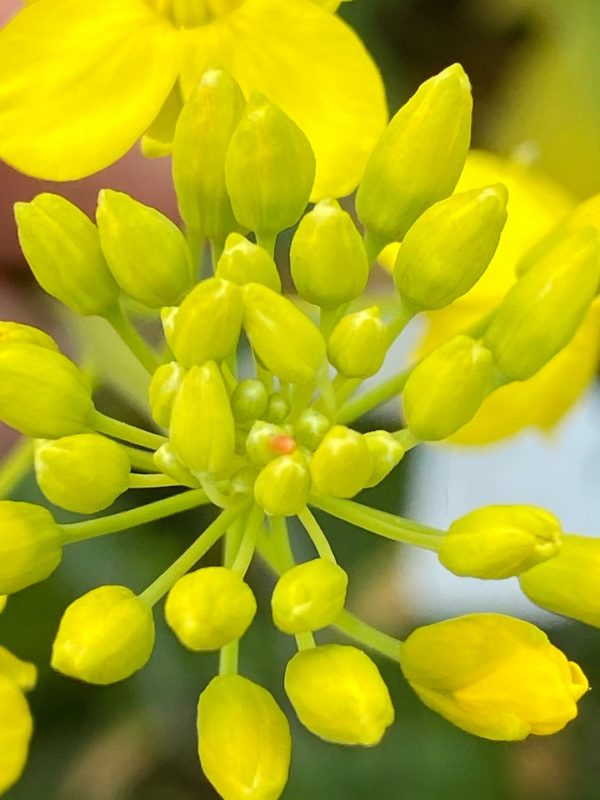
Looking for larvae at Frazer Homestead Preserve | Staff archive
In May and June, all over the south end of San Juan Island, where once stood a sea of pasture grasses or pockets of old meadow reverting to forest, and with little in the way of nectar resources for pollinators, there now stand flashes of bright yellow. Yellow blooms of Brassica rapa (field mustard), a familiar plant to anyone who has turned over soil on the island, wave in the breeze as if beckoning one of the rarest insects of them all to come visit. These patches were created purposely—seeded with mustard, and protected from browsing deer or livestock—with the sole intention of attracting Island Marble Butterfly.
Now a federally listed endangered species, the Island Marble Butterfly is a tiny, creamy-white butterfly with yellow-green splotches on the undersides of its wing rivaling a Jackson Pollock painting. It is rare (less than a few hundred are known to exist), endemic (only found on San Juan Island), and the focus of much attention by multiple agencies and private community members working together with a singular goal: recovering this species before it disappears entirely from our planet.
From the Island Marble’s stronghold at the American Camp prairie, a network of “butterfly gardens,” aka habitat patches, spreads northward along Cattle Point Road and up into San Juan Valley. A few additional habitat patches have been created East of the National Historic Park at Cattle Point. The goal behind creating these habitat patches is to attract Island Marble to establish population “outposts” beyond the American Camp prairie, so that the species is less vulnerable to a single catastrophic event, such as a brushfire. The patches have been designed to allow this rare insect to complete its entire life cycle in relative safety.
 Through this past spring and summer, the Preservation Trust continued its habitat patch work (which began in 2016). These patches are located at the Land Bank’s Frazer Homestead Preserve, and at SJPT’s Phelps and Sundstrom Preserves. This spring, we were quite thrilled to discover—for the second time since the butterfly gardens were created—the presence of Island Marble Butterfly at the Frazer Preserve location.
Through this past spring and summer, the Preservation Trust continued its habitat patch work (which began in 2016). These patches are located at the Land Bank’s Frazer Homestead Preserve, and at SJPT’s Phelps and Sundstrom Preserves. This spring, we were quite thrilled to discover—for the second time since the butterfly gardens were created—the presence of Island Marble Butterfly at the Frazer Preserve location.
On May 31, the first of 15 tiny eggs were discovered attached to the buds of an emerging mustard flower. This “bud platform” is the perfect crib to hold the emerging caterpillar, which will hatch out from its bright orange egg casing after about 10 days. The soft bed that once cradled the egg then becomes the tiny caterpillar’s larder as it begins to munch away on the developing flower. Over the course of its development, which will take about 25 days, the tiny Island Marble larva will molt five times (each stage of growth is called an instar). As of the week of the summer solstice, there were three caterpillars left—two of which that had already entered fourth instar (kind of the home stretch). If they survive to the fifth instar, they will stop eating, travel off the host mustard plant that served as their nursery and food source, and onto nearby vegetation to pupate. If all goes well, they will emerge as adult butterflies next spring. And the cycle begins again.
Through eons of evolution, the Island Marble female is genetically programmed to find just the right location to deposit her precious eggs. So she goes aloft to search. She’s searching for that flash of yellow that will beckon her to the perfect bed in which to leave the hopes of her species wrapped up in a tiny orange package. She won’t know if her eggs will survive, or if they will fall victim to deer, spiders, snails, sheep, birds, cattle, the tractor, or the human foot. But as long as she is on San Juan Island, she will continue to search, each spring. And the Preservation Trust, and the many others who are committed to not seeing yet another species disappear in our lifetime, will continue to work to make sure her search is not in vain.
–Kathleen Foley Lewis, Conservation Project Manager

First instar

Orange egg on mustard flower

Second instar

Fourth instar
